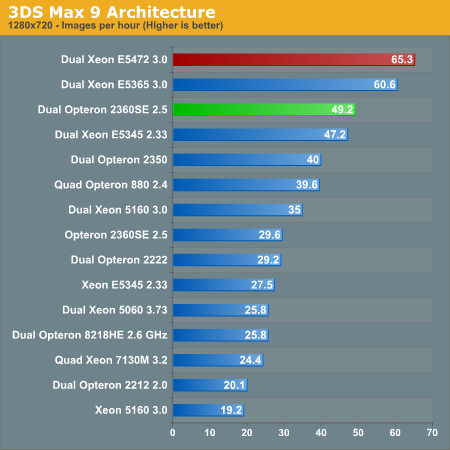AMD's 3rd generation Opteron versus Intel's 45nm Xeon: a closer look
by Johan De Gelas on November 27, 2007 6:00 AM EST- Posted in
- IT Computing
3ds Max 9 (32-bit Windows)
We tested with the 32-bit version of 3ds Max version 9, which has improvements that help multi-core systems but which is not as aggressively tuned for SSE as LINPACK and zVisuel. We used the "architecture" scene, which has been a favorite benchmarking scene for years. We performed all tests with 3ds Max's default scanline renderer, we enabled SSE support, and we rendered at HD 720p (1280x720) resolution. We measured the time it takes to render ten frames (frames 20 to 29).
As promised, we profiled our different benchmarks to understand them better. We performed profiling with AMD's CodeAnalyst; VTune profiling will follow later. 3ds Max runs four modules when you render:
- Render
(46% of the time)
- Ray-FX (28%)
- Geometry (15%)
- Core (11%)
To keep things simple, we summarized our findings with a weighted average over all modules.
| 3dsmax Profiling | |
| Profile | Total |
| Average IPC (on AMD 2350) | 1 |
| Instruction mix | |
| Floating Point | 39% |
| SSE | 12% |
| Branches | 13% |
| L1 datacache ratio | 0.56 |
| L1 Instruction ratio | 0.27 |
| Performance indicators on Opteron 2350 | |
| Branch misprediction | 6% |
| L1 datacache miss | 1% |
| L1 Instruction cache miss | 5% |
| L2 cache miss | 0% |
As you can see, 3ds Max is mostly about floating-point performance with a bit of SSE instructions. It runs perfectly in the L1 and L2 cache of our CPUs. To make the graph easier to read we did not report our results in the classic way (rendering time) but expressed them in images rendered per hour (10 images * 3600 seconds divided by render time). Higher is therefore better.

The Xeon 5472 is about 8% faster than its older brother and widens the gap from the AMD Armada. We included quite a few results of older tests. This benchmark focuses on the CPU; chipset and RAM choices don't impact performance much. Interestingly, the Opteron 2350 is about as fast as four 2.4GHz single-core Opterons. Thus, in software with a "small dash" of SSE, the new architecture is about 20% faster. If we extrapolate our AMD quad-core results to 3GHz, the result would be about 59 images per second, which indicates that AMD's newest is about 10% slower than Intel clock for clock. That is no real surprise anymore: FLOPS showed us that the raw x87 FP and SSE power of AMD's latest architecture is slightly lower than the newest Xeon. It also can only overpower the Xeon 53xx if there are enough divisions involved. AMD's Barcelona architecture will only show a real advantage in bandwidth limited FP situations such as SPECfp2006 and many HPC applications.










43 Comments
View All Comments
Hans Maulwurf - Wednesday, November 28, 2007 - link
Agreed, I have not seen an article as good as this one for years at Anandtech. And not for some time on other review sites as well.Thank you.
JohanAnandtech - Tuesday, November 27, 2007 - link
Thanks people. This kind of articles take ridiculously amounts of time and I really appreciate that you let me know that you liked the article. It keeps us going. (and I mean that!)magreen - Tuesday, November 27, 2007 - link
Excellent article, thorough and with amazing depth and expertise. Keep up the great work AT!Bluestealth - Tuesday, November 27, 2007 - link
I agree, it was a very well done article. I can't wait to see how Intel's processors preform on Hyper... errr... Common System Interface (next year?). I believe that I will be buying AMD until that happens though for any servers.Regs - Tuesday, November 27, 2007 - link
Yeah, every time I see "Johan De Gelas" I have to read it.I like the added info on the Barc's L3 cache and the intro-factoid about the new architecture.
I agree that the Barc's arrival is a year late and joined the party a little too shy. Integer performance will likely have to be addressed in the Bulldozer in 2-3 years. Which is 2-3 years too long. I would be really surprised if they can manage anything other than a die shrink for Shanghi with maybe more L3 cache and some tweaks for cache latency and SSE.
Just seems like AMD took a nose dive in development for their processors in the past 3-4 years. After the K8 I would think they would be able to come up with something more innovative. Revolutionary should of never entered their heads and they should actually look down upon themselves for using such a word after 4 years.
jones377 - Tuesday, November 27, 2007 - link
Any chance you could use the same tools to profile desktop applications as well in the future?DigitalFreak - Tuesday, November 27, 2007 - link
Three months or so since "launch", and you still can't get a server with AMD quad-core chips from any of the big 3 vendors (HP, Dell, IBM). AMD really screwed the pooch on this one.jojo4u - Tuesday, November 27, 2007 - link
Yuck, ugly GIF on the first page. Please use PNG because 256 colors are not enough for screenshots ;)deathwombat - Saturday, December 1, 2007 - link
In addition to being less ugly, PNG's higher compression would also make the file smaller (using less bandwidth), which I assume is what they were going for.jkostans - Tuesday, November 27, 2007 - link
Didn't even notice.